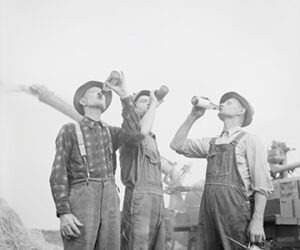Crowing Glory: A brief history of crown caps
Although mankind has been brewing beer (and other alcoholic options) for centuries, storage has long proved problematic. Bottled beverages of centuries past were sealed with a variety of less-than-optimum options, mostly comprising of the stopper or the cork. This may work fine for still beverages like wine but corks can and will pop out if carbonation is involved.

In 1892, William Painter addressed this persistent problem with an invention that revolutionized the bottled beverage industry. On February 2, he filed patent 468,258 for the world’s first crown cap – shortly followed up by a second patent for a bottle cap lifter, or opener. The original cap sported 24 serrations that crimped securely onto the rim of a bottle, creating an airtight seal; safely securing its contents in good condition. Painter, who was born in Ireland before emigrating to the U.S., was 20 years old and an inventing maverick (somehow his train ejection seat didn’t quite gain the same traction though).
Early iterations of the crown cap employed a thin disc of cork beneath the metal surface, intended to stop the liquid from coming into direct contact with the metal whilst maintaining an airtight seal. Painter’s first company to mass-produce his new crown caps, the Crown Cork and Seal Company, reflected this design element in its new name (having evolved from the erstwhile Bottle Seal Company). By the 1930s, the Crown Cork and Seal Company was estimated to be selling around half of the entire world’s bottle caps.
SMALL SIZE, BIG SUCCESS
The crimped cap had literally opened up new possibilities for the beverage business, not just beer. It had been helped by greatly improved manufacturing methods of the early 20th century, including uniform, machine-made glass bottles with identical rims on which a standard diameter of crown cap could be consistently crimped. And while breweries might re-use their bottles, the single-use crimped cap – distorted when pried from its perch – became one of the world’s first successful disposable products. In fact, King Gillette – a former Crown Cork and Seal Company salesman – was so inspired by the single-use success story that he developed the world’s first disposable razorblade.
And while breweries might re-use their bottles, the single-use crimped cap – distorted when pried from its perch – became one of the world’s first successful disposable products.
Solid cork liners were used inside caps until around 1915, when manufacturing advancements allowed shavings of waste cork to be formed into composite sheets, which were then cut into circular shapes and inserted in the lids. This standard design remained relatively unchanged until the 1960s, when plastic discs – less prone to deterioration or contamination — superseded the old cork seals. The other deviation in design was the move from 24 serrations to just 21 on more modern examples.
THE HOMEBREWERS’ HELPER
Whilst other options are available – such as the ceramic plug on wire springs favored by commercial brewer Grolsch – the crimpable cap is simple, cheap, and effective. Caps can be purchased in a variety of colors to help identify different batches. Several companies offer small-scale customizable caps with which to make your bottles look their best.
Most U.S. bottles take the standard 26 mm cap, as opposed to the 29 mm, and both can be easily applied with either a hand-held “wing capper,” or a bench-mounted unit. The process hasn’t changed in over a century. However, one technological advancement is the introduction of the oxygen-absorbing cap, great for longer-term storage.
So next time you crimp a lid in place or pry those 21 teeth off, remember you’re holding in your hand a little piece of history from 1892 that remains as relevant today as ever.



